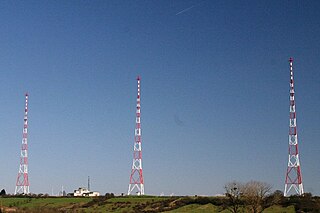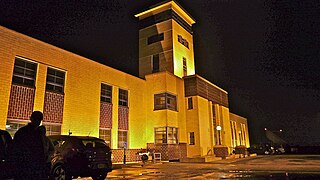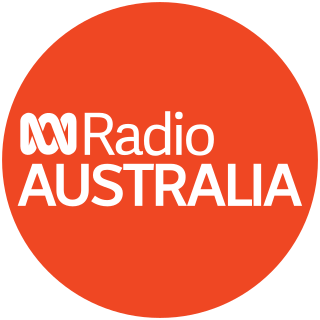International broadcasting, in a limited extent, began during World War I, when German and British stations broadcast press communiqués using Morse code. With the severing of Germany's undersea cables, the wireless telegraph station in Nauen was the country's sole means of long-distance communication.

AM broadcasting is radio broadcasting using amplitude modulation (AM) transmissions. It was the first method developed for making audio radio transmissions, and is still used worldwide, primarily for medium wave transmissions, but also on the longwave and shortwave radio bands.

Radio National, known on-air as RN, is an Australia-wide public service broadcasting radio network run by the Australian Broadcasting Corporation (ABC). From 1947 until 1985, the network was known as ABC Radio 2.
B105 is a commercial FM radio station broadcasting in Brisbane, Queensland, Australia, on a frequency of 105.3 MHz, and is part of Southern Cross Austereo's Hit Network. The station has undergone numerous branding changes over the years; it was branded as B105 following its conversion from AM to FM. This lasted until a co-branding as Hit 105.3 B105, then as Hit B105 and finally back to B105 in July 2020.

Bald Hills is the northernmost suburb in the City of Brisbane, Queensland, Australia. In the 2021 census, Bald Hills had a population of 7,000 people.

The Junglinster Longwave Transmitter is a longwave broadcasting facility used by RTL near Junglinster, Luxembourg, which went into service in 1932. Its aerial consists of three free-standing steel-framework towers, which are ground fed radiators. These towers formed a directional aerial for the frequency 234 kHz and until 1980 were 250 metres high. Since 1980 their height has been 215 metres.

The Droitwich transmitting station is a large broadcasting facility for long-wave and medium-wave transmissions, established in 1934 in the civil parish of Dodderhill, just outside the village of Wychbold, near Droitwich in Worcestershire, England. The site is the location of the British Broadcasting Corporation's most powerful long-wave transmitter, which together with the two Scottish long-wave transmitters at Burghead and Westerglen forms a network broadcasting on the same frequency. The masts can be seen to the east from the M5 motorway, between Droitwich and Bromsgrove, as well as to the west from the Herefordshire/Worcestershire border. At night, the two sets of aircraft warning lights are visible from a long distance. The station is owned and operated by Arqiva.

The Skelton Transmitting Station is a radio transmitter site at grid reference NY433376 near Skelton, Cumbria, England, about 5 miles (8 km) north-west of Penrith, run by Babcock International and owned by the Ministry of Defence. Since the Belmont Mast in Lincolnshire was shortened in 2010, the mast at Skelton has been the tallest structure in the United Kingdom.

The Voice of America's Bethany Relay Station was located in Butler County, Ohio's Union Township about 25 miles (40 km) north of Cincinnati, adjacent to the transmitter site of WLW. Starting in 1944 during World War II it transmitted American radio programming abroad on shortwave frequencies, using 200,000-watt transmitters built by Crosley engineers under the direction of R.J. Rockwell. The site was developed to provide 'fallback' transmission facilities inland and away from the East Coast, where transmitters were located in Massachusetts, on Long Island in New York, and in New Jersey, all close to the ocean, subject to attack from German submarines or other invading forces.
Vision Christian Radio is an Australian narrowcast radio station owned and operated by Vision Christian Media, an affiliate of United Christian Broadcasters. It broadcasts a Christian radio format of music and talk from studios in the Brisbane suburb of Underwood, to a network of more than 800 AM and FM radio frequencies.

ABC Radio Brisbane is an ABC Local Radio station in Brisbane, Queensland. It is one of the largest stations in the network, serving as a base for Queensland programming – many programs are broadcast across the ABC Local Radio network in regional and rural areas of Queensland when those stations are not carrying local programming.

ALLISS is a somewhat rotatable antenna system for high power shortwave radio broadcasting in the 6 MHz to 26 MHz range. An ALLISS module is a self-contained shortwave relay station that is used for international broadcasting.

ABC Radio Australia, also known as Radio Australia, is the international broadcasting and online service operated by the Australian Broadcasting Corporation (ABC), Australia's public broadcaster. Most programming is in English, with some in Tok Pisin.

4BH 1116 is the on-air identifier of a radio station in Brisbane, the state capital of Queensland, Australia. It broadcasts on a frequency is 1116 kHz in the AM radio band and is simulcasted in DAB+ on channel 9B. It is owned by Nine Entertainment Co and run under a lease agreement by Ace Radio.

The Wiederau transmitter is the oldest broadcasting facility in Saxony. It is located near Wiederau, a village which is part of the municipality of Pegau, and is used for medium-wave, FM and Television broadcasting.

The Lisnagarvey transmitting station is a facility for mediumwave broadcasting located in the townland of Magherageery, on the southern edge of Lisburn, Northern Ireland. It is close to Sprucefield shopping centre and about one mile from the middle of Lisburn.

Shortwave relay stations are transmitter sites used by international broadcasters to extend their coverage to areas that cannot be reached easily from their home state. For example, the BBC operates an extensive net of relay stations.

ABC Radio and Regional Content, later ABC Radio, was the division of the Australian Broadcasting Corporation responsible for radio output and regional content. This was the first public radio station in Australia, which opened in Sydney at 8:00pm on 23 November 1923 under the call sign 2SB.
4RN is the callsign for the Australian Broadcasting Corporation's Radio National station in Brisbane, Queensland. The station operates at a frequency of 792 kHz.
















